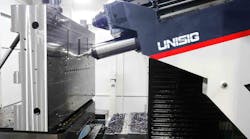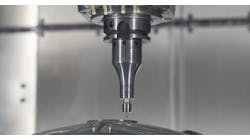New orders for machine tools took another significant increase during March, rising to $508.7 million for the month — 42% higher than the February total and 22.7% higher than the March 2017 figure. Through the first quarter of 2018, U.S. machine tool orders have totaled $1.24 billion, 26.0% higher than the comparable result for 2017.
AMT – the Assn. for Manufacturing Technology issues the month U.S. Manufacturing Technology Orders (USMTO) report to track new machine-tool (manufacturing technology) demand nationwide and in six regional markets. The data is supplied to AMT by participating companies that produce and distribute metal-cutting and metal-forming and -fabricating equipment, including domestically manufactured and imported machinery and equipment.
According to AMT, “manufacturing technology orders (provide) a reliable leading economic indicator as manufacturing industries invest in capital metalworking equipment to increase capacity and improve productivity.”
“The strong growth in the U.S. manufacturing technology market echoes similar growth in both European and Asian MT markets, leading to increased pressure on the supply chain and longer lead times for new machine builds,” stated Doug Woods, AMT president. “Our members have been getting more orders than they can fill, and customers are turning to used equipment to fulfill their needs.
“While this signals strong activity in the manufacturing industry, the potential impact for tariffs to impede market growth is adding an element of uncertainty and concern,” Woods added, echoing a concern offered recently by AMT chairman Steve Stokey, in the release of the monthly Cutting Tool Market Report. That report tallies the progress of current manufacturing activity, while the USMTO is an indicator of future manufacturing trends.
AMT noted that the March machine-tool orders saw volume increasing in every region, as well as nationwide. In particular, it noted segments focused on industrial markets showed “uniformly strong double-digit growth, led by aerospace and forging markets that had month over month growth rates in the triple digits.”
In the Northeast region, March machine-tool demand rose 3.1% from February to $79.26 million, 19.2% higher than in March 2017. For the year-to-date, regional orders for metal-cutting equipment are up 20.1%
In the Southeast region, new orders for metal-cutting equipment totaled $59.55 million, 103.7% higher than in February and 2.7% higher than in March 2017. January-March new orders for metal-cutting equipment in the region stand at $125.2 million, 103.7% higher than last year’s comparable total.
The North Central-East region’s total manufacturing technology orders during March wee $104.25 million, 20.3% higher than February, 7.2% higher than March 2017, and bringing year-to-date new orders to $275 million, a 20.3% increase over last year.
The North Central-West region’s total manufacturing technology orders increased 71.6% from February to $102.63 million in March, 62.2% ahead of the March 2017 figure. It raised the year-to-date total for the region to $241.3 million, up 71.6% versus the three-month total for 2017.
In the South Central region, new orders for metal-cutting equipment for March totaled $52.4 million, 30.1% higher than February, 47.6% higher than March 2017, and bringing the YTD total to $139.87 million — 30.1% higher than the year-ago result.
The West region’s March new orders for metal-cutting equipment total $103.4 million, 63.3% higher than February and 34.6% higher than March 2017. For the Jan.-March period, regional orders for metal-cutting equipment rose to $226.44 million, 63.3% higher than last year’s comparable total.
“Consumers continue to drive this recovery and their increased demand is putting a strain on the supply chain,” stated Pat McGibbon, AMT’s vice president of Strategic Analytics. “That demand will continue to sustain growth in the manufacturing technology market for the rest of the year.”







